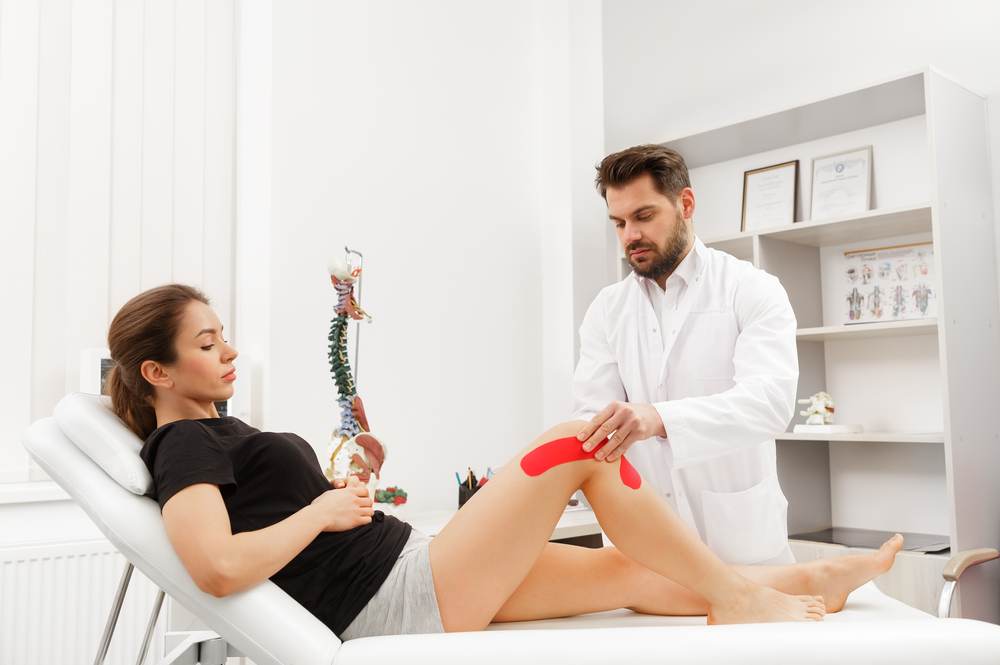 You typically don’t see a car accident coming, so when you don’t know it’s about to happen, you can’t brace yourself for the impact. The sudden surprise of a car accident is often what ends up leading to car accident injuries. In fact, knee pain is common for both drivers and passengers after a car accident. When another vehicle collides with yours, it can cause your body to jolt and jostle around. In the event of a rear-end collision, this means your body can jolt forward and collide with parts of the car in front of you, like the steering wheel or dashboard. While seat belts are designed to help protect you from serious injury, they may not always prevent you from every car accident injury. A dashboard knee injury is common with a rear-end collision if the force of impact thrusts one or both knees into the dashboard. In some cases, this could lead to minor bruising or scrapes, while other times, you might end up with a soft tissue injury or fractured kneecap.
You typically don’t see a car accident coming, so when you don’t know it’s about to happen, you can’t brace yourself for the impact. The sudden surprise of a car accident is often what ends up leading to car accident injuries. In fact, knee pain is common for both drivers and passengers after a car accident. When another vehicle collides with yours, it can cause your body to jolt and jostle around. In the event of a rear-end collision, this means your body can jolt forward and collide with parts of the car in front of you, like the steering wheel or dashboard. While seat belts are designed to help protect you from serious injury, they may not always prevent you from every car accident injury. A dashboard knee injury is common with a rear-end collision if the force of impact thrusts one or both knees into the dashboard. In some cases, this could lead to minor bruising or scrapes, while other times, you might end up with a soft tissue injury or fractured kneecap.
Understanding Dashboard Knee Injuries
When a car accident causes your knee to collide with the dashboard in front of you, you end up with what’s commonly referred to as a dashboard knee injury. The medical term for this type of injury is typically a posterior cruciate ligament injury, or PCL injury. The PCL is a ligament made of thick tissue that connects your thigh bone to your shin bone. The posterior cruciate ligament runs along the back of your knee before crossing with the anterior cruciate ligament, or ACL, at the knee cap. When your knee collides with the dashboard or other part of the vehicle, you could end up with minor scrapes and bruises, soft tissue damage, or even bone and joint damage. The most common type of dashboard knee injury is the PCL injury because of how the force and impact put pressure on this vital ligament in your knee. A PCL injury, or dashboard knee injury, accounts for approximately 20% of knee injuries.
How the Posterior Cruciate Ligament Works
Did you know that the posterior cruciate ligament is actually the strongest ligament of the knee joint? In fact, the PCL that runs along the back of your knee provides stability for the knee joint, especially along the back. So, this ligament helps prevent your knee from bending backward or twisting too much side to side. Every time you bend and straighten your knee, you engage the posterior cruciate ligament. Because of how vital the PCL is to stabilizing the knee joint, any damage to this ligament can leave you feeling unstable and like you can’t put your full weight on the knee while standing or walking around.
You might be more familiar with the ACL, or anterior cruciate ligament. An ACL injury is common among professional athletes in contact sports like football, soccer, and basketball. The anterior cruciate ligament is actually weaker than the posterior cruciate ligament, which makes the ACL more vulnerable to injury. However, in the event of a car accident, the PCL can become damaged along with other structures in the knee.
Symptoms of a Dashboard Knee Injury
If you slam your knee into the dashboard during a car accident, it is highly likely that you will start noticing pain and other symptoms quickly. Depending on the severity of the injury, you may notice redness, bruising, and swelling around the knee and at the site of impact. While the kneecap hit the dashboard, if the PCL gets injured then you may feel tenderness along the back of your knee. A PCL injury after a car accident can leave you with instability, especially when trying to bear weight on the affected knee. Pain in and around the knee joint is common, along with swelling and difficulty walking if the injury is severe enough. A dashboard knee injury can cause difficulty standing and walking around, so you might need support getting out of the car or moving around in the days or weeks following the accident. Any type of trauma to your knee can negatively impact everyday routines like moving from sitting to standing, walking around, and even driving your car.
How to Diagnose a Dashboard Knee Injury
 If you receive medical attention by first responders at the scene, they may suspect a dashboard knee injury and recommend you go to the emergency room as soon as possible if the injury is moderate to severe. An emergency room doctor or car accident doctor can diagnose what type of dashboard knee injury you have using a combination of tests, including a physical examination. First, your doctor may look for any abnormalities in how the knee looks and make note of any swelling, inflammation, and obvious disfigurement. Then, they will gently touch your knee to feel for injuries and check for swelling or fluid build-up. Your doctor may request you move your knee in various directions to test the impact on your range of motion.
If you receive medical attention by first responders at the scene, they may suspect a dashboard knee injury and recommend you go to the emergency room as soon as possible if the injury is moderate to severe. An emergency room doctor or car accident doctor can diagnose what type of dashboard knee injury you have using a combination of tests, including a physical examination. First, your doctor may look for any abnormalities in how the knee looks and make note of any swelling, inflammation, and obvious disfigurement. Then, they will gently touch your knee to feel for injuries and check for swelling or fluid build-up. Your doctor may request you move your knee in various directions to test the impact on your range of motion.
If your doctor suspects a dashboard knee injury, they will likely also run diagnostic imaging tests for more information. An X-ray can identify injury or damage to your leg and knee bones and may also be used to rule out a fracture or other injury with similar presentation and symptoms. If your doctor suspects a soft tissue injury, then they will likely request a CT scan or MRI for a more detailed look at the ligaments in your knee. Unlike X-rays, both CT scans and MRI results offer a better look at the soft tissues like the PCL and ACL, along with the bones in your joints.
Treatment Options for a PCL Injury
 Your treatment options for knee pain after a car accident injury will depend on your specific diagnosis, your symptoms, and the severity of your injury. Here are some examples of treatment options for a dashboard knee injury after a car wreck.
Your treatment options for knee pain after a car accident injury will depend on your specific diagnosis, your symptoms, and the severity of your injury. Here are some examples of treatment options for a dashboard knee injury after a car wreck.
Home Remedies
Mild knee pain after a car accident could be managed at home with your doctor’s permission. Some home remedies may be recommended along with other treatment options. For scrapes, bruises, and overstretched muscles and other soft tissues, your doctor may recommend the RICE method: rest, ice, compression, and elevation. Rest is key to recovering from many injuries, especially a knee injury, because of how much weight and pressure we put on our knees with everyday movements and activities. Icing your knee can help reduce swelling and inflammation, while also providing a temporary numbing sensation. Compression refers to a knee brace or splint that will help provide better stability to the joint and also help reduce inflammation. Finally, elevate your knee above your heart when sitting or lying down by propping it up on a stool or stack of pillows. This helps prevent too much blood flow to the area and allows the healing process to begin.
Splints & Braces
Your doctor may recommend a splint or brace to provide additional support to your knee while you heal from a dashboard knee injury. A knee brace or splint will help restrict your movements so you don’t put too much pressure and strain on your injured knee. This will also serve as a reminder to limit your physical activity while you heal from the injury.
Physical Therapy
Physical therapy can help you recover from a wide range of car accident injuries, including dashboard knee injuries. When you meet with a physical therapist, they will create a personalized plan of care that will typically involve a combination of stretches, exercises, and other hands-on approaches to pain relief and improving your strength and mobility. Your physical therapist will work with you to strengthen the muscles and soft tissues that provide structure and support to your knee, which can help prevent future injuries. If a knee injury leaves you with restricted range of motion after a car accident, then your physical therapist can walk you through stretches and exercises to safely regain mobility.
Surgery
In some cases, you may need surgery to address a serious knee injury after a car accident. Orthopedic surgeons will typically recommend you try conservative treatment approaches before surgery, though sometimes surgery is necessary to treat an acute knee injury. Surgical procedures may include surgery to repair a torn ligament or a minimally invasive procedure known as arthroscopic surgery that utilizes smaller incision sites for a faster recovery time.
How a Car Accident Doctor Can Help
Visit AICA Orthopedics in Jonesboro for comprehensive treatment and care after a car accident. Our car accident doctors have the knowledge and skills to help you recover from dashboard knee injuries safely and effectively. At AICA Orthopedics in Jonesboro, our team of doctors includes orthopedic surgeons, physical therapists, chiropractors, and neurologists who work together to provide each person with individualized attention and care. Our multi-disciplinary approach means you get the treatment and care you need all in one, convenient location. Call or contact us today to schedule an appointment to talk about any knee pain after a car accident.
